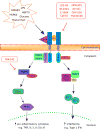Targeting toll-like receptor-4 (TLR4)-an emerging therapeutic target for persistent pain states
- PMID: 29889119
- PMCID: PMC7890571
- DOI: 10.1097/j.pain.0000000000001306
Targeting toll-like receptor-4 (TLR4)-an emerging therapeutic target for persistent pain states
Abstract
Toll-like receptors (TLRs) are a family of pattern recognition receptors that initiate signaling in innate and adaptive immune pathways. The highly conserved family of transmembrane proteins comprises an extracellular domain that recognizes exogenous and endogenous danger molecules and an ectodomain that activates downstream pathways in response. Recent studies suggest that continuous activation or dysregulation of TLR signaling may contribute to chronic disease states. The receptor is located not only on inflammatory cells (meningeal and peripheral macrophages) but on neuraxial glia (microglia and astrocytes), Schwann cells, fibroblasts, dorsal root ganglia, and dorsal horn neurons. Procedures blocking TLR functionality have shown pronounced effects on pain behavior otherwise observed in models of chronic inflammation and nerve injury. This review addresses the role of TLR4 as an emerging therapeutic target for the evolution of persistent pain and its role in noncanonical signaling, mediating anomalous pro-algesic actions of opiates. Accordingly, molecules targeting inhibition of this receptor have promise as disease-modifying and opioid-sparing alternatives for persistent pain states.
Conflict of interest statement
References
-
- Chaperonin 10 as a putative modulator of multiple Toll-like receptors for the treatment of inflammatory diseases. Expert Opinion on Therapeutic Patents. 2007;17:1299–1308.
-
- Abdollahi-Roodsaz S, Joosten LA, Roelofs MF, Radstake TR, Matera G, Popa C, van der Meer JW, Netea MG, van den Berg WB. Inhibition of Toll-like receptor 4 breaks the inflammatory loop in autoimmune destructive arthritis. Arthritis Rheum. 2007;56:2957–2967. - PubMed
-
- Aderem A, Ulevitch RJ. Toll-like receptors in the induction of the innate immune response. Nature. 2007;406:782–787. - PubMed
-
- Andrade P, Hoogland G, Del Rosario JS, Steinbusch HW, Visser-Vandewalle V, Daemen MA. Tumor necrosis factor-alpha inhibitors alleviation of experimentally induced neuropathic pain is associated with modulation of TNF receptor expression. J Neurosci Res. 2014;92:1490–1498. - PubMed
Publication types
MeSH terms
Substances
Grants and funding
LinkOut - more resources
Full Text Sources
Other Literature Sources
Medical


